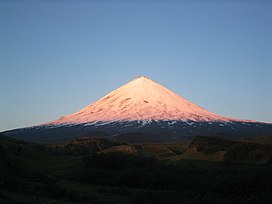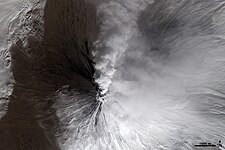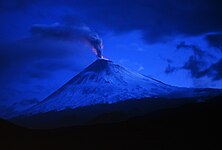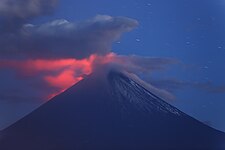Klyuchevskaya Sopka
| Klyuchevskaya Sopka | |
|---|---|
 Klyuchevskaya Sopka in January 2007 | |
| Highest point | |
| Elevation | 4,754 m (15,597 ft) |
| Prominence | 4,649 m (15,253 ft) Ranked 13th |
| Isolation | 2,748 km (1,708 mi) |
| Listing | Ultra |
| Coordinates | 56°03′22″N 160°38′39″E / 56.056044°N 160.644089°E |
| Geography | |
Location in Kamchatka Krai, Russia | |
| Location | Kamchatka, Russia |
| Parent range | Eastern Range |
| Geology | |
| Mountain type | Stratovolcano (active) |
| Last eruption | 2023 |
| Climbing | |
| First ascent | 1788 by Daniel Gauss and 2 others |
| Easiest route | basic rock/snow climb |
 | |
Klyuchevskaya Sopka (Russian: Ключевская сопка; also known as Klyuchevskoi, Russian: Ключевской) is a stratovolcano, the highest mountain of Siberia and the highest active volcano of Eurasia. Its steep, symmetrical cone towers about 100 kilometres (60 mi) from the Bering Sea. The volcano is part of the natural Volcanoes of Kamchatka UNESCO World Heritage Site. Klyuchevskaya Sopka is ranked 15th by topographic isolation.
Klyuchevskaya appeared 7,000 years ago.[1] Its first recorded eruption occurred in 1697,[1] and it has been almost continuously active ever since, as have many of its neighboring volcanoes. It was first climbed in 1788 by Daniel Gauss and two other members of the Billings Expedition.[2] No other ascents were recorded until 1931, when several climbers were killed by flying lava on the descent. As similar dangers still exist today, few ascents are made.
Eruptions[edit]
Klyuchevskaya volcano has erupted 110 times during the Holocene Epoch.[1]
2007 eruption[edit]
Beginning in early January 2007, the Klyuchevskaya volcano began another eruption cycle. Students from the University of Alaska Fairbanks and scientists of the Alaska Volcano Observatory traveled to Kamchatka in the spring to monitor the eruption. On 28 June 2007, the volcano began to experience the largest explosions so far recorded in this eruption cycle. An ash plume from the eruption reached a height of 10 km (33,000 ft) before drifting eastward, disrupting air traffic from the United States to Asia and causing ashfalls on Alaska's Unimak Island.[citation needed]
2010 eruption[edit]
As early as 27 February 2010, gas plumes had erupted from Klyuchevskaya Sopka (reaching elevations of 7,000 m (22,966 ft)) and during the first week of March 2010, both explosive ash eruptions and effusive lava eruptions occurred until, by 9 March, the ash cloud was reported to have reached an elevation of 6,000 m (19,685 ft). Also, significant thermal anomalies have been reported and gas-steam plumes extended roughly 50 km (31 mi) to the north-east from the volcano on 3 March.[citation needed]
2012 eruptions[edit]
On 15 October 2012, the volcano had a weak eruption that stopped the following day. Also a weak thermal eruption occurred on 29 November 2012, then stopped again, as all of its neighboring volcanoes Bezymianny, Karymsky, Kizimen, Shiveluch, and Tolbachik erupted more actively and continuously, taking a major magma supply load off of Klyuchevskaya Sopka.[citation needed]
2013 eruptions[edit]
On 25 January 2013, the volcano had a weak Strombolian eruption that stopped the following day. During January 2013, all volcanoes in the eastern part of Kamchatka —Bezymianny, Karymsky, Kizimen, Klyuchevskaya Sopka, Shiveluch, and Tolbachik erupted, with the exception of Kamen.[citation needed]

On 15 August 2013, the volcano had another weak Strombolian eruption with some slight lava flow that put on an excellent fireworks display before stopping on 21 August 2013, when Gorely Volcano woke up and started erupting again in relief of Klyuchevskaya Sopka.[citation needed]
On 12 October, Klyuchevskaya had another three days of on-and-off eruptions with anomalies and a short ash plume, possibly indicating Strombolian and weak Vulcanian activity. An explosion from a new cinder cone low on Kliuchevskoi's southwest flank occurred on 12 October. An ash plume rose to altitudes of 6–7 km (20,000–23,000 ft), and drifted eastward. The eruptions weakened and paused by 16 October 2013.[3]
On 19 November, a strong explosion occurred, and observers reported that ash plumes rose to altitudes of 10–12 km (33,000–39,000 ft) and drifted southeast. The Aviation Color Code was raised to Red. Later that day, the altitudes of the ash plumes were lower and the eruptions weakened and stopped again.[citation needed]
On 7 December, activity at Kliuchevskoi significantly increased, having continued during 29 November – 7 December, prompting KVERT to raise the Alert Level to Red. Ash plumes rose to altitudes of 5.5–6 km (18,000–20,000 ft) above sea level and drifted more than 212 km (132 mi) northeast and over 1,000 km (621 mi) east. According to a news article, a warning to aircraft was issued for the area around the volcanoes. Video showed gas-and-steam activity, and satellite images detected a daily weak thermal anomaly. On 9 December, the Alert Level was lowered to Green when the eruptions abruptly stopped.[citation needed]
2015 eruptions[edit]
On 2 January 2015, after a one-year period of inactivity, the volcano had a Strombolian eruption which stopped on 16 January 2015. Minor eruptions resumed on 10 March 2015 and stopped on 24 March 2015. On 27 August 2015, the volcano had another Strombolian eruption which ended 16 hours later.[citation needed]
2019 eruptions[edit]
Kluchevskaya Sopka saw renewed eruption activity beginning in 2019.[4] On 25 October 2019, the volcano had another weak Strombolian eruption which ended some 30 hours later.[citation needed]
2020 eruption[edit]
A volcanic eruption occurred on 9 December 2020.[citation needed]
2022 eruption[edit]
A volcanic eruption started on 20 November 2022.[5]
2023 eruptions[edit]
A volcanic eruption started on 22 June 2023.[6] The June eruption follows nearby eruptions on 11 April 2023 in other volcanoes in the area.[7] A significant eruptive event occurred as part of ongoing activity on 1 November 2023, sending ash as high as 13 km (8 mi) above sea level and causing flight delays as far away as Vancouver, BC, on 4-5 November 2023. [8]
2022 climbing accidents[edit]
In September 2022, nine people died while climbing Kluchevskaya Sopka. They were part of a 12-strong group of Russian nationals, which included two guides. Five climbers were killed after a fall at about 4,000m. Another four, including a guide, died on the mountainside afterwards. A rescue helicopter managed to land at 1,663m at the fourth attempt, bringing rescuers who faced a two-day climb to reach a volcanologists' hut at 3,300m where the three survivors were sheltering.[9]
Images[edit]
-
Klyuchevskaya Sopka in July 2006
-
Satellite image of Klyuchevskaya Sopka in April 2010 by NASA.
-
Satellite image and map of Klyuchevskaya Sopka in 2002 by NASA.
-
The eruption of October 1994.
-
The eruption of February 2005.
-
The eruption of February 2010 taken by NASA ASTER.
-
The eruption of March 2010.
-
The eruption of 16 November 2013. Ushkovsky, Tolbachik, Zimina, Udina, and Bezymianny are also visible.
-
Kluchevskaya Sopka
-
The eruption of summer 1993
-
The eruption of July 2016
-
The eruption of October 2016
-
The eruption of June 2020
See also[edit]
- List of volcanoes in Russia
- Kronotsky Nature Reserve
- Valley of Geysers
- Kamchatka Peninsula
- Kamchatka Volcanic Eruption Response Team
- List of highest points of Russian federal subjects
References[edit]
- ^ a b c "Klyuchevskoy: Eruptive History". Global Volcanism Program. Smithsonian Institution. Retrieved 2021-06-25.
- ^ Dobkin, Josef (1989), "The Living Giants of Kamchatka", The American Alpine Journal, The American Alpine Club: 104, ISBN 0-930410-39-4
- ^ "Global Volcanism Program | Report on Klyuchevskoy (Russia) — 16–22 October 2013". volcano.si.edu. Retrieved 2018-04-26.
- ^ "Global Volcanism Program | Klyuchevskoy". Smithsonian Institution | Global Volcanism Program. Retrieved 2022-05-18.
- ^ "Two volcanoes in Russia's far east rumble into action". MSN. Retrieved 20 November 2022.
- ^ "Eurasia's Biggest Volcano Starts to Erupt in Russian Far East". Bloomberg.com. 2023-06-23. Retrieved 2023-06-23.
- ^ "Russian Volcano Eruption Spews Ash, Prompts Air Travel Warning". Bloomberg.com. 2023-04-11. Retrieved 2023-06-23.
- ^ "Eruption of Eurasia's tallest active volcano sends ash columns above a Russian peninsula". APNews.com. 2023-11-01. Retrieved 2023-11-01.
- ^ "Klyuchevskaya Sopka: Climbers killed during a fall on Russian volcano". BBC News. 2022-09-06. Retrieved 2022-09-10.
External links[edit]
- Klyuchevskaya Sopka (Climbing). on author's site sgan2009.ru "Russia begins here" (in Russian)
- "Klyuchevskoy". Global Volcanism Program. Smithsonian Institution. Retrieved 2008-12-18.
- Klyuchevskoy Volcano live webcam
- "Klyuchevskaya Sopka". Peakware.com. Archived from the original on 2016-03-04. – photos
- Science Daily article on the 2007 eruption's disruption of air traffic















